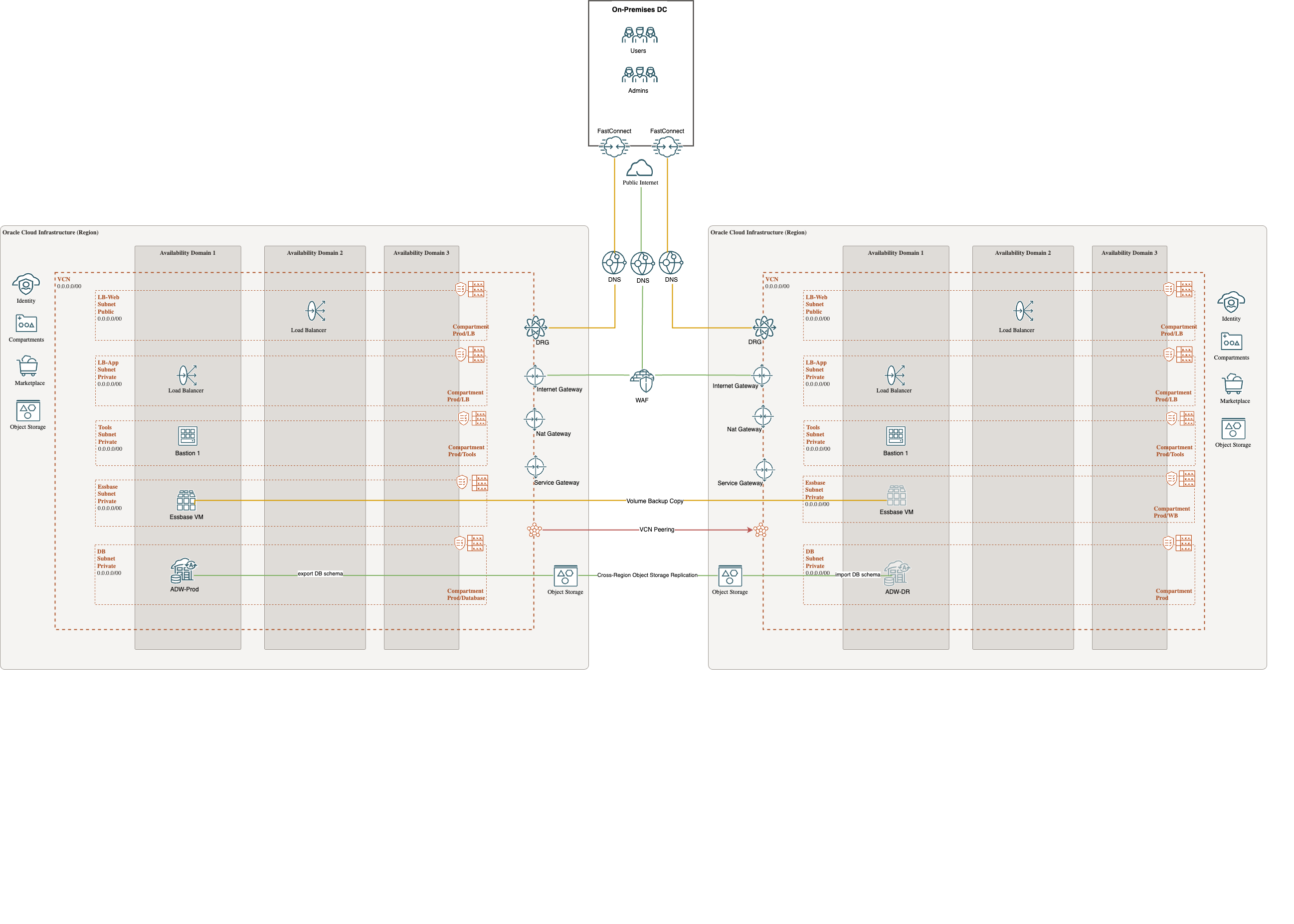Introduction
As more organizations shift their enterprise planning and analytics to the cloud, protecting critical workloads like Oracle Essbase becomes a top priority. A solid disaster recovery (DR) strategy is essential to ensure continuity and resilience. If you’re working with Essbase in Oracle Cloud Infrastructure (OCI), whether you’re migrating for the first time or refining your setup, it’s important to know how to design DR effectively. In this article, we’ll walk through how to back up and restore Essbase Marketplace (stack deployment) in a cross-region DR environment.
Cross-Region Disaster Recovery: Architecture Overview
A well-architected disaster recovery design in Oracle Cloud Infrastructure (OCI) ensures that regional or data center outages do not interrupt access to Oracle Essbase.
By leveraging OCI’s cross-region replication and backup capabilities, Essbase environments can be protected beyond a single region. Critical data, application artifacts, and configurations are securely replicated to a standby region, ensuring that a complete and current copy is always available. If a regional outage occurs, the Essbase instance can be restored in the secondary region with minimal downtime.
This approach protects against:
- Regional failures: If an entire OCI region becomes unavailable, workloads can be restored in the secondary region with minimal business disruption.
- Data loss risks: Automated backups and replication ensure that Essbase data and metadata remain intact and recoverable.
With this architecture, organizations gain the resilience needed for uninterrupted analytics and financial planning, no matter what happens at the infrastructure level.
 Key Architectural Elements
Key Architectural Elements
- Primary and DR Regions:
The solution spans two OCI regions.
- Network Connectivity:
- FastConnect provides both primary and secondary region connectivity back to the on-premises data centre. This approach protects against the network connection failure to one of the regions.
- Internet Gateway, NAT Gateway, Service Gateway, and Web Application Firewall (WAF) control user and admin traffic flows securely.
- VCN Peering: Facilitates secure internal OCI regional communication to streamline synchronization and DR failover.
- Primary and standby Essbase instances
You must use the same version of the Essbase Marketplace image in both the primary and standby regions. Since the Marketplace offers only the latest version of the image, you should deploy the standby region at the same time as the primary region. After any upgrade to the primary region, remember to upgrade the standby region as well, so both always use the same Essbase image version.
Important: Follow the deployment instructions for the target (standby) Essbase Marketplace image as described here: Non-Oracle-Scripted Backup and Restore (for version 21.1 and earlier) or Backup and Restore (for version 21.2 and later)
- Multi-Layer Isolation and Compartmentalization:
Clear segmentation between public, application, and database resources with OCI compartments for governance and security.
- Bastion Hosts:
In both regions, bastion hosts provide secure, auditable admin access.
Backup and cross-region restore
Backup:
- Essbase Schema and Block Volume Backups: To create backups of both your Essbase schema and associated block volumes follow the steps outlined in the Essbase documentation: Non-Oracle-Scripted Backup and Restore (for version 21.1 and earlier) or Backup and Restore (for version 21.2 and later) Cross-Region Backup Replication:
- Copy Block Volume Backup: Use the instructions for copying volume backups between regions to create copies in the standby region.
- Schema Backup Replication: If your schema backups are stored in Object Storage, enable cross-region replication for those object storage buckets to replicate your backups across regions. Using DBMS_CLOUD Package is possible to export and import data from/to Autonomous database.
Restore
- Follow the instructions to restore in the standby region the volume and schema backups: Non-Oracle-Scripted Backup and Restore (for version 21.1 and earlier) or Backup and Restore (for version 21.2 and later)
Application-Level Backup and Restore with Lifecycle Management (LCM)
Application-level backup focuses on individual Essbase applications or cubes, great for granular protection, migrations or replicating smaller applications between environments or regions. Export and import instructions for LCM can be found here: https://docs.oracle.com/en/database/other-databases/essbase/21/essad/back-and-restore-applications.html
Replicating the export files to standby region
Store the export files in object storage. Enable cross-region replication for those object storage buckets
Best Use:
- Lightweight migration of selected apps. LCM can be too slow for very large application exports.
- Application-level DR: keep only critical cubes synced across regions
- Testing, environment refresh, or promoting development changes
Practical Tips
- Frequency Matters: Use OCI API to script and schedule backup and replication tasks. Set backup schedules based on your data change rate and business needs. For block volume and DB backups make sure the Essbase services are stopped.
- Test Restores Regularly: Perform regular test restores (both instance and application-level) to validate your recovery plan.
- Secure Your Backups: Always protect backup files and exports with proper OCI security controls and encryption.
Conclusion
An effective disaster recovery strategy for Oracle Essbase requires protection at both the infrastructure and application layers. At the infrastructure level, block volume backups with cross-region copy and object storage replication provide full server recovery capabilities in the event of a regional outage. At the application level, Lifecycle Management (LCM) export/import ensures that Essbase artifacts, such as applications, databases, security settings, and calculation scripts are synchronized across regions.
By combining these mechanisms, organizations can recover entire Essbase environments or selectively restore individual applications, depending on the scope of the failure. This layered approach enables consistent recovery objectives and supports resilient cross-region deployments in Oracle Cloud Infrastructure (OCI)
